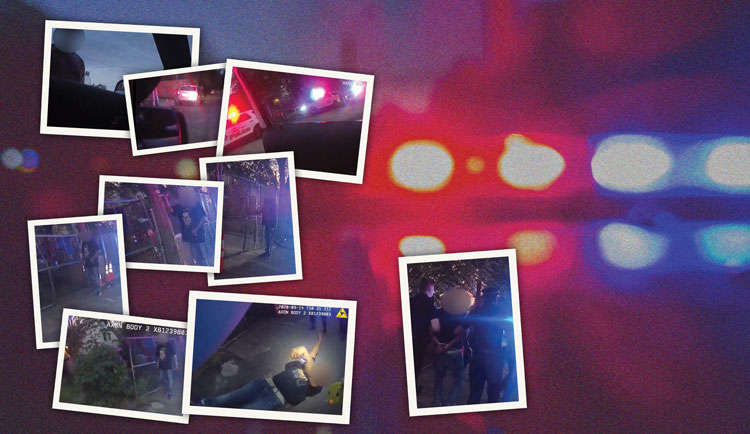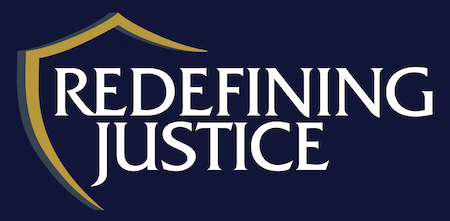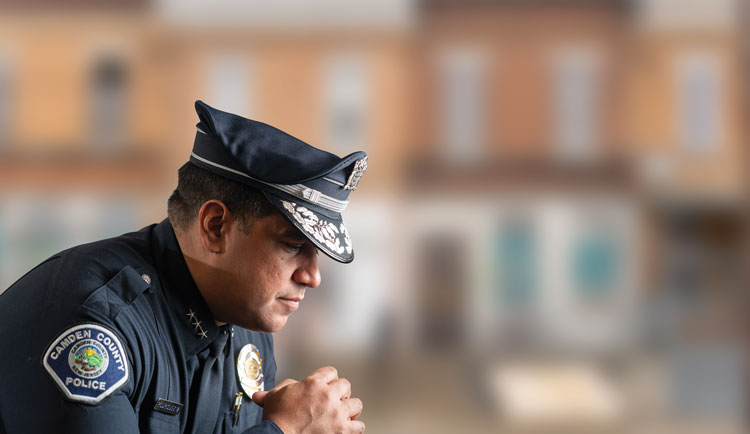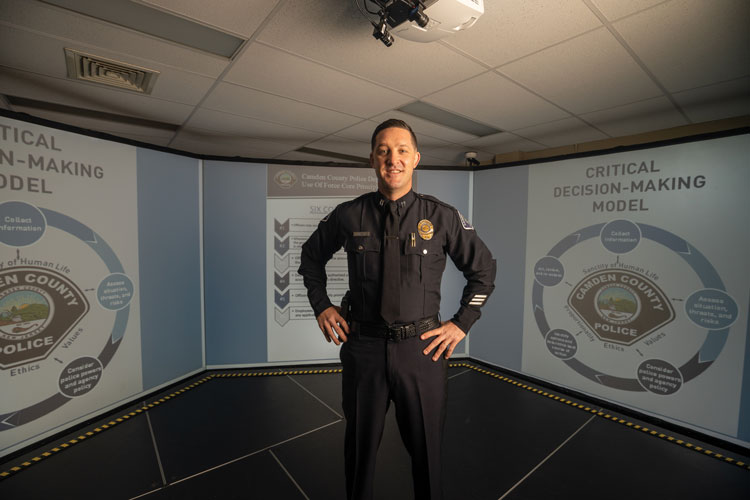More police departments are training officers in de-escalation techniques, but does it work?

Photo illustration by Sara Wadford/YouTube/Shutterstock
Early in September just before dawn, police officers in Camden, New Jersey, cautiously moved in on a rape suspect they were following. The man, armed with a knife, parked his SUV in an alley, got out and slowly walked toward the officers.
“Drop the knife! Stop moving!” an officer yelled. “Stop moving!”
Still gripping the knife, the man kept walking toward the officers, who stepped back to maintain a safe distance.
“We’re trying to help you, man,” another officer said.
“I’ll stab you,” the suspect replied.

The officers, some with their guns drawn, others ready with Tasers, waited for his next move. Camden County police are trained to hold back deadly force when possible—to first try to de-escalate situations like this.
De-escalation training is becoming more common in police departments across the country as public pressure mounts to reduce the number of people killed by law enforcement officers. Last year, police killed 1,127 people, according to the research group Mapping Police Violence.
In most of those cases, officers initially responded to nonviolent offenses or situations in which no crime was reported.
Of those killed by police last year, 180 had a knife or sharp object, and 80 were unarmed; about half had a gun. Of those unarmed, 45 were people of color.
Could police have avoided killing—whether the victims were armed or not?
Advocates of de-escalation believe that many such deaths can be prevented. Yet what de-escalation means and how effective it is remain subject to debate as police and the public try to determine whether it puts officers at greater risk or helps prevent unnecessary killings.

Chief Gabriel Rodriguez: “We do things totally opposite now. We understand that de-escalation is important.” Photo by Arnold Adler/ABA Journal
Respecting life
The rape suspect in Camden refused repeated commands to drop his knife, and police officers continued to take steps to avoid shooting him. Even though he had a deadly weapon, they didn’t consider him an immediate threat because the officers were able to keep their distance.
Camden’s 400-member police force came a long way to reach this point. For decades, the city was once considered among the most dangerous in the country, beset with high murder rates and complaints of excessive force. In 2013, the city’s police department was disbanded and became a countywide operation, instituting a series of reforms under then-Chief J. Scott Thomson. Among them was de-escalation training, which stresses patience and talking to suspects rather than using aggressive takedowns.
Then in 2019, the Camden County Police Department, working with New York University School of Law’s Policing Project, developed an updated use-of-force policy to complement its de-escalation training. It was backed by the American Civil Liberties Union of New Jersey and supported by the local Fraternal Order of Police lodge. At its core is the department’s declaration that officers “respect the sanctity of life.”
Police use-of-force policies vary from department to department but have been guided, in part, by two U.S. Supreme Court decisions.
In 1985’s Tennessee v. Garner, the court ruled that a state law allowing police to shoot an unarmed, fleeing suspect was unconstitutional.
The court found that the law violated the Fourth Amendment’s prohibition against unreasonable seizure—in this case, the seizure being the apprehension of an unarmed criminal suspect. The use of deadly force to stop the suspect, the court reasoned, far exceeded the state’s interest in apprehending the suspect—who in this case was a teenager wanted in connection with a burglary.
Four years later, the court ruled in another Fourth Amendment case, Graham v. Connor, that a police officer may only use force, deadly or otherwise, that a “reasonable” officer would use when facing similar circumstances. That case stemmed from an incident in which police, suspicious after a man quickly left a convenience store, detained and handcuffed him only to later learn he was diabetic and was having an insulin reaction.
The policy in Camden County goes further than both cases by seeking to avoid use of force that may be considered lawful but not necessary. “Whenever feasible, officers should attempt to de-escalate confrontations with the goal of resolving encounters without force,” the policy states. Officers may only use force “as a last resort.”
Camden County Police Chief Gabriel Rodriguez says when he was a young officer, such policies didn’t exist. “The feeling back then was that it was better to be judged by 12 than carried by six,” he says. “This was the mentality of the police officer back then. Get there, draw a line in the sand, and do not retreat. We do things totally opposite now. We understand that de-escalation is important, using the proper tactics is important, creating space, giving yourself more time.”
Farhang Heydari, an attorney and the executive director of the Policing Project, worked with Camden police and former chief Thompson to bring the use-of-force policy and training together.
“Training has to come hand in hand with the policy,” he says. “I think we crafted a policy that put Camden out front of many departments. It definitely can serve as a model for other departments.”
A call for help
The encounter with the rape suspect in Camden began early on the morning of Sept. 14 when Sgt. Michael Harper, while on patrol, heard a woman calling for help. Harper stopped and asked the woman what happened and had her get inside his squad car. She told Harper she had been sexually assaulted by a man with a knife.
As they spoke, the man she said assaulted her walked up to the officer’s car holding a knife. He swung the knife several times at the car.
“That right there, when I came on the force 18 years ago, would have been a deadly force situation,” Rodriguez says. “We call them lawful but awful shootings.”
Harper, known for his cool, radioed that the sexual assault suspect had a knife.
He did not get out of the squad car. The man got into his SUV and drove away.
Officers in the area quickly located the SUV and followed it for several blocks until the suspect stopped and got out of the vehicle.
“Put your hands up!” one of the officers yelled.
“Put your hands on top of your head, bro,” another said.
The suspect got back in his car and drove off.
In the old days, this might have triggered a police chase. But in Camden, the strategy is to avoid putting anyone’s life in danger, says Capt. Kevin Lutz, who leads the department’s training.
Lutz describes de-escalation as a multilayered process. “I don’t think it’s easily defined. It’s a unified way of thinking through crisis,” he says. “At the end of the day, de-escalation is more of a culture of how you deal with individuals, not just during a crisis but in day-to-day interactions. As officers, we may be dealing with people on the worst day of their life, and we want to make sure we’re there to help them, not hurt them.”
But sometimes they face very real threats. “If you put a gun into the scenario, it’s a completely different set of circumstances at that point, and there are minimal things you can do to de-escalate someone who is threatening you or someone else with a gun,” Lutz says.

Camden County Police Capt. Kevin Lutz, above, helped the department with use-of-force training. Photo by Arnold Adler/ABA Journal
Training to think differently
The training model in Camden was developed by the Police Executive Research Forum, a nonprofit police research and policy organization based in Washington, D.C.
Chuck Wexler, executive director of PERF, says the idea came to him after he visited the United Kingdom to study police techniques.
His visit came around the same time as the 2014 fatal shooting of Michael Brown by police in Ferguson, Missouri, and the subsequent riots.
“It got me thinking about de-escalation, and why can police in the U.K. arrest people without shooting them?” Wexler says. “It’s about training, not just policy.”
Wexler concluded that while police departments may have use-of-force policies that look good on paper, they can’t be fully effective without proper training. “Changing policy is easy,” he says. “We’re talking about changing culture. Changing culture is the Mount Everest of police reform. How do we implement this strategy and really turn police thinking on its head?”
The organization developed training that encourages officers to keep themselves out of harm’s way while communicating with subjects.
The goal of the training PERF designed is to build rapport that leads to a peaceful surrender. It’s designed for situations involving people who are unarmed or armed with weapons other than guns.
“The notion that cops have to make a split-second decision is not always the case,” Wexler says. “It’s about communicating, working as a team.”
De-escalation training also recognizes that many of those who police encounter may have mental health problems, may be severely intoxicated from drugs or alcohol, and in some instances are seeking “suicide by cop.” (See “Calls for Help,” April-May, page 46.)
The program Wexler helped develop is called ICAT training, or Integrating Communications, Assessment and Tactics. Camden became one of the first test sites for the training. Since 2016, when the first ICAT training guide was published, more than 600 police agencies have attended training sessions, and dozens of agencies are using it.
Other agencies teach police de-escalation techniques, and the training can be as varied as the more than 18,000 law enforcement agencies—large and small—across the country. The common theme is to try to avoid deadly confrontations. But does it work?
Anecdotal evidence suggests that it does, though there haven’t been enough comprehensive studies to confirm it. “Despite vast promotion from politicians, academics, expert panels and the public, we know little about the effects of de-escalation training on officers and police-citizen interactions,” noted a study last year in Criminology & Public Policy.
One of that study’s authors is Robin S. Engel, professor of criminal justice at the University of Cincinnati and director of the International Association of Chiefs of Police / UC Center for Police Research and Policy.
“I was shocked at the lack of evidence about police training, not to mention de-escalation training,” she says. “Officers were concerned that if they engaged in de-escalation that they were going to get seriously injured or killed. And people would say, ‘You’re gonna kill cops doing this because you’re teaching them to hesitate.’”
However, Engel and colleagues took a closer look at the Louisville Police Department in Kentucky, which has implemented the ICAT training. Their study offers one of the first large-scale evaluations of de-escalation training for police.
The examination in Louisville, where police were heavily criticized after Breonna Taylor was killed in a no-knock raid in March 2020, showed that concerns de-escalation might cause more harm than good were unfounded. The data showed that after the training, officers had 28% fewer incidents involving use of force, 26% fewer injuries to citizens and 36% fewer injuries to officers.
Von Kliem, an attorney, former prosecutor and former police officer in Topeka, Kansas, is the community relations director of the Force Science Institute, which does scientific research, behavioral analysis and training in the use of deadly force.
Kliem says that while officers can be trained in de-escalation techniques, situations often involve making educated guesses, forcing officers to calculate the risk of taking action against the risk of standing back. It’s a layered and complex situation and should not be hastily judged. “Always remember there is a human being behind the badge,” he says.
Each situation, Kliem notes, requires asking what the government interest is in stopping or arresting someone. Cops must be aware of the ongoing tension between demands for law and order and demands for social justice. Will the department and the community support what they do?
He says the edict to only use force when necessary is vague. “That’s such an arbitrary and ambiguous phrase. No one can determine that in advance of using force,” he says. “It sounds great, and we all want to use less force, as necessary. How long do you wait? Was it necessary? This is the position we put cops in all the time.”

Camden, New Jersey, once considered among the most dangerous cities in the country, is now policed by a countywide department that instituted a series of reforms in 2013 that focus on better community relations and a “sanctity of life” policy. Photos courtesy of Camden Police Department; Timothy A. Clary/AFP via Getty Images
Police perspective
Using de-escalation to defuse potentially dangerous situations is really nothing new, some veteran cops say. But the formal training is a more recent development.
“When I first came on 35 years ago, there was no de-escalation training. What the senior officers did teach us was how to talk to people, how to get out of cars and start conversations and really communicate, to learn community policing,” says St. Petersburg, Florida, Police Chief Anthony Holloway, chair of the Law Enforcement Committee of the ABA Criminal Justice Section. “So maybe that was unofficial de-escalation training.”
Official or not, Holloway believes police departments have fallen short in teaching community relations. “I blame myself. We forgot to teach officers how to talk to people,” he says. “We took out the human part of it.”
New Jersey attorney Stuart J. Alterman, a former cop who represents police officers in use-of-force complaints and other matters, argues police are too often expected to act like social workers. “We’re trained to deal with people who do bad things,” he says. “We’re trained to deal with people who are prone to commit crimes.”
Alterman, who also worked as a county corrections officer and prosecutor, believes formal de-escalation policies are not necessary. “I have a great deal of concern about what is being espoused today,” he says.
Cops, he says, are asking themselves whether these techniques can really work. “How long do I sit there and talk to this person, and how effective will I be?” he says. “I think it’s a fine line that has to be handled with each individual case.”
He recalls being trained in the use-of-force continuum, guidelines officers use to resolve a situation that can escalate when civilians or criminal suspects are not cooperative. “The idea was that you can go one step above what the suspect is trying to use against you,” he says.
Alterman says cops want more support and less judgment. “When you’re trying to push de-escalation because it’s politically expedient, you also have to let officers know that if they have to use deadly force, we’ll back them up,” he says. “Now we have cops second-guessing themselves all the time.”
Tense situations are never easy and often require a split-second response, Alterman adds. Having been a cop himself, he understands the pressure, and he says his clients feel persecuted. “You’re supposed to go home at the end of your shift. You didn’t sign up to get hurt or disabled, or worse, dead.”
The final confrontation
The officers in Camden caught up once more with the sexual assault suspect in the alley, where he threatened to stab them. As the scene unfolded, the police watch commander, who had been monitoring the situation on the radio, reminded the officers to maintain a safe distance and keep working to de-escalate the situation.
The suspect, who was 5 feet, 10 inches tall and 200 pounds, kept moving closer. The officers ordered him to drop the knife.
“What’s your name?
“I’ll stab you.”
“What’s your name, man? C’mon, man.”
Officers again told him to drop the knife, but he kept moving closer.
“Taser, Taser, Taser!” one of the officers, John Reed, yelled. There was a loud pop. He hit the suspect, sending him to the ground, groaning with pain.
“You got me good,” the suspect said to the officer.
His name was Cesar Sanchez. The 36-year-old was charged with three counts of aggravated sexual assault while armed, aggravated assault with a deadly weapon, simple assault, possession of a weapon for an unlawful purpose, terroristic threats, resisting by flight and restraint.
“He didn’t want to die,” Lutz says. “He didn’t want to necessarily kill these officers or kill someone else. He was having a moment of mental crisis.”
The entire incident was captured by nine police body cameras and has since been compiled into a training video. “We review body cam footage on a daily basis,” says Rodriguez, noting that these videos also reveal their shortcomings. “We’re not saying we’re the best, we’re not waving the flag and saying we’re the greatest.”

Photos by Timothy A. Clary/AFP via Getty Images; Andrew Burton/Getty Images
National progress
Katie Ryan, campaign manager for Campaign Zero, a national advocacy organization that seeks to end police violence, says the incident in Camden is an example of how police can avoid escalating a situation. “There is a level of ownership law enforcement can take in a situation that is already volatile,” says Ryan, who reviewed a Camden police video of Sanchez’s arrest. “They were able to employ a cooler approach.”
Campaign Zero developed policies to help reduce police violence called 8 Can’t Wait after George Floyd’s murder by Minneapolis police officer Derek Chauvin in May 2020. Among the eight recommendations: require de-escalation and exhaust all other means before using deadly force.
“We’re starting to see a lot more police departments aligned with our campaign of 8 Can’t Wait,” Ryan says, adding that one or more of their policies have been adopted in 340 cities since June 2020.
Campaign Zero has studied the use-of-force policies of at least 500 law enforcement agencies, a fraction of the 18,000 out there, and sometimes faces resistance from departments who see the organization through a narrow lens. “We get lumped into the narrative that we’re anti-police. I think the criticism is ill-informed,” Ryan says.
And there is still the challenge of overcoming bias—explicit or implicit—in how police handle calls and communicate with people of color, says Johnetta Elzie, one of the founders of Campaign Zero. Elzie also believes “the militarization of police” has made some officers see citizens, especially people of color, as enemy combatants, not humans—a culture that will be difficult to change.

Johnetta Elzie: “If the culture is toxic, you can change as many rules as you want on paper. It doesn’t mean there will be any actual people to enforce the change.” Photos by Emily Kassie/The Huffington Post
“As far as empathy training and anti-bias training? I personally don’t believe those things work because I don’t believe you can teach empathy,” she says. “If the culture is toxic, you can change as many rules as you want on paper. It doesn’t mean there will be any actual people to enforce the change.”
A sign that the de-escalation movement is catching on came when New Jersey Attorney General Gurbir Grewal announced in December that the state would update its use-of-force policy for the first time in 20 years in an effort to reduce violent interactions with civilians.
The new policy is scheduled to take effect in 2022 and calls for all of the state’s 38,000 law enforcement officers to undergo de-escalation training and outlines other strategies for limiting the use of force. “That was the first statewide wholesale adoption of our 8 Can’t Wait policy,” Ryan says.
At the national level, the George Floyd Justice in Policing Act, if passed by Congress, would encourage federal officers to use de-escalation techniques when possible and create grants for de-escalation training in other law enforcement agencies.
“You can come up with policies, all kinds of reform, but if you don’t instill this in the culture of the agency overall—the sanctity of life, all those key things we have in our use-of-force policy—you’re not going to get the change or results that we’re seeing,” Rodriguez says.
Camden County has seen real progress. Since the de-escalation training began, the number of excessive force complaints against the department dropped from 65 in 2014 to three in 2020. Police have fatally shot three people during that same period, and all were considered justified.
“It didn’t happen overnight,” Lutz says. “It was years in the making. And we’re always looking to get better every day. I can tell you that it’s safer policing this way. We’re still getting the violent offenders. We’re still seizing illegal guns off the street. And we’re doing it the right way.”
In the case of the knife-wielding rape suspect, the officer who first confronted him could have made a very different decision. “He could have got out of his vehicle, drawn his service weapon, given a command and shot him, and it would have been legal,” Lutz says. “That’s not what we train to do here, and [we] have seen multiple success stories.”
Sanchez was one of them. They got him good, as he said. And they got him alive.
This story was originally published in the June/July 2021 issue of the ABA Journal under the headline: “Defusing Deadly Force: More police departments are training officers in de-escalation techniques—but does it work?”
Write a letter to the editor, share a story tip or update, or report an error.


